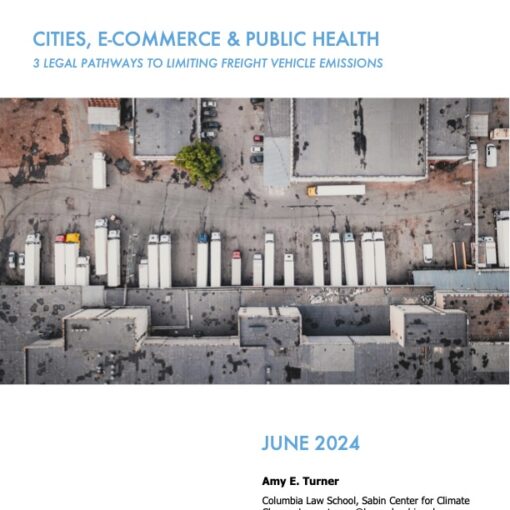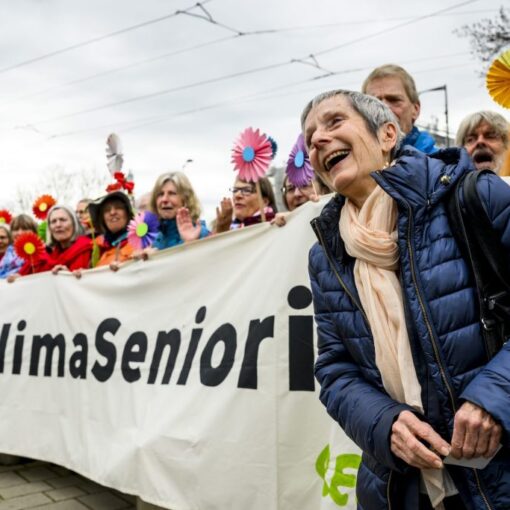By Amy Turner
This blog post is adapted from testimony delivered at the New York City Department of Buildings hearing on proposed rule §103-14, Procedures for Reporting on and Complying with Annual Greenhouse Gas Emissions for Certain Buildings in connection with the City’s building performance standard, Local Law 97. The written version of the testimony from which this post is adapted was submitted to the Department of Buildings, and an abbreviated oral version was delivered at the November 14, 2022 hearing.
I am testifying in strong support of Local Law 97, and to advocate for robust implementation of the Law. New York City has rightly been touted as a climate leader because of Local Law 97, but without careful implementation, the City could find itself trailing on climate. The Department of Buildings’s proposed rules, and others that will be needed for full implementation of Local Law 97, are critical to the Law’s effectiveness. In particular, the Department should take a hard look at how Local Law 97’s renewable energy credit (or REC) compliance mechanism currently undermines Local Law 97’s integrity.
Renewable Energy Credits as a Compliance Mechanism
Local Law 97 and the rules we are discussing today allow the use of RECs as a tool for compliance. Building owners subject to Local Law 97 may purchase RECs, subject to certain limitations, in exchange for a deduction in their building’s reported annual emissions. A central limitation is that these RECs must have as their source a renewable energy resource “located in or directly deliverable into zone J load zone,” the New York City area of the electricity grid.
RECs are a tool for placing a price on carbon, part of a broader ecosystem in which New York City building owners may use market tools – purchasing RECs or carbon offsets or paying financial penalties – as part of their compliance strategy. While intended to offer a small amount of flexibility to building owners who might have trouble complying with Local Law 97’s emissions limits, with these rules they risk falling into the same traps that have ensnared other carbon pricing efforts.
Market mechanisms like the ones contemplated by Local Law 97’s REC program have generally failed to reduce carbon emissions at the levels policymakers project for one or both of two reasons. The first is that the market mechanism does not require additionality, a concept that refers to an energy or emissions reduction only taking place because of the purchase of the credit or offset. The second is that the price is too low. Local Law 97, and these rules, risk failure on both grounds.
Additionality
Critical to any carbon market mechanism’s success in actually reducing carbon emissions is the central feature that the market mechanism causes investment in carbon reducing behavior that would not have occurred otherwise. While a vague concept of additionality may have been baked into Local Law 97 as it was initially passed in 2019, it was insufficiently defined then, and fully missing in today’s context. Since 2019, New York State has passed the Climate Leadership and Community Protection Act, which commits to a fully green electricity grid by 2040; New York City has contracted with Hydro-Quebec to deliver 1,250 megawatts of renewable electricity through hydropower; and NYSERDA already has more than 4,000 megawatts of renewable wind power in development offshore. RECs associated with all of these renewable energy resources will be available to building owners to fulfill their Local Law 97 obligations without actually improving building energy performance. In other words, building owners will not have to invest in projects that would otherwise not have occurred but for their involvement in order to reap the benefits of this alternative Local Law 97 compliance pathway. The Local Law 97 REC program therefore lacks this critical additionality component.
Carbon markets lacking additionality have in the past failed to achieve their goals by causing the reduction of fewer GHG emissions than projected. For example, a carbon offset program called the U.S. Forest Protocol was set up by the California Air Resources Board, or CARB, to allow emitters to offset their emissions by purchasing offsets associated with forest planting and protection efforts. The Protocol was imperfectly developed, and it allowed forest preservation efforts that would have occurred anyway to sell certified carbon offsets satisfying the CARB program. Because many forests were already in existence, and some even already protected by conservation easements and other legal tools, the program has yielded far fewer emissions reductions than anticipated – as much as 80 million tons fewer. Had the California law not allowed for compliance via offsets, the forests still would have existed, and the state would have reaped the benefits of both the forests’ carbon sequestration and the law’s greenhouse gas reductions. (Significant amounts of carbon supposedly sequestered in California’s forest program have also burned in wildfires, releasing the stored carbon.)
The problem with the California system is directly analogous to the situation here. Significant renewable energy resources are already contemplated to be available in and around New York City in the coming years. This will be the case regardless of whether or not Local Law 97 allows for compliance through the purchase of RECs, and it is the case because state law already requires the greening of the electricity grid. Because the Local Law 97 REC program now effectively lacks a meaningful additionality requirement, it will allow for a double-counting of emissions reductions that will obscure the fact that material reductions in building emissions and energy use are not occuring.
Oversupply and Price
Local Law 97 also risks failure because the high availability of RECs sets the lowest price for compliance, and the price most rational building owners will choose, too low. In other words, because RECs for energy feeding into Zone J will be so readily available, they will be less expensive and therefore more appealing to building owners than the actual upgrades the City so desperately needs for its building stock. Building owners will choose to purchase RECs, which though tied to renewable energy resources are a purely financial tool, rather than actually reduce emissions from their buildings.
This echoes the experience of other carbon markets. Despite carefully crafted markets, political factors push prices far too low. The result is that emitters continue emitting because it is so inexpensive to purchase the market mechanism offered as an alternative compliance tool. For example, the European Union’s Emissions Trading System, or ETS, which required many large emitters across 30 countries in Europe to cap their emissions and trade credits for excess emissions, was largely ineffective, at least in its early stages, because of an oversupply of credits that drove the price per ton of carbon as low as €3. Similarly, a voluntary carbon offset market called the Chicago Climate Exchange collapsed in 2010 when prices fell, in some cases as low as five cents per ton, due to oversupply.
Local Law 97 and these rules face the same risk now. There are far more RECs compliant with Local Law 97 available now or in the coming years than were initially anticipated, so while New York City is not making an affirmative choice with respect to the price of those RECs, by allowing an oversupply of these RECs the City is ensuring a far lower price than should be the case. This changes the economics of Local Law 97 compliance and will cause building owners to purchase RECs rather than improve their buildings to achieve energy and emissions reductions. It should be noted that it is not too late to change the economics of the Local Law 97 REC program; EU ETS continues to be refined. Other carbon market mechanisms, including the Regional Greenhouse Gas Initiative, or RGGI, and the California program described above, have strict limits on how many RECs or offsets a given emitter may use towards its compliance with the applicable law (3.3 percent and four to 6 percent of the emitter’s allowable pollution, respectively), and such a mechanism would be wise here as well. Advocates have suggested that the availability of RECs be limited to 30 percent of a building’s excess greenhouse gas emissions above its allotted pollution cap under Local Law 97, and only to offset electricity use, and I concur with these recommendations. These limitations would require that some building energy improvements and emissions reductions actually take place.
Conclusion
Given this history of failures within carbon markets, particularly where there is a slew of inexpensive credits as is the case here, it is my recommendation that the Adams administration, the Department of Buildings, and the City Council impose significant limitations on the REC program, both (1) in the form of an additionality requirement beyond the zone J limitation currently in Local Law 97, and (2) through a thirty percent limit on how much of a building’s emissions exceedance over its Local Law 97 cap may be covered by RECs, mitigating some of the additionality and oversupply concern.
The City should not allow such inexpensive RECs lacking additionality to flood the market in a way that was not anticipated. To do so threatens the integrity not only of the Local Law 97 REC compliance mechanism, but of Local Law 97 itself.
Amy Turner is the Director of the Cities Climate Law Initiative at the Sabin Center for Climate Change Law at Columbia Law School.






